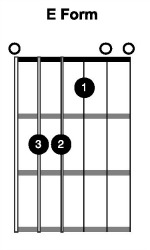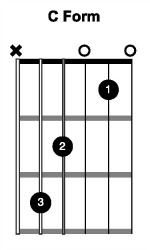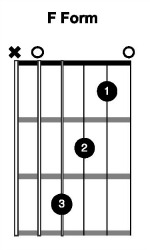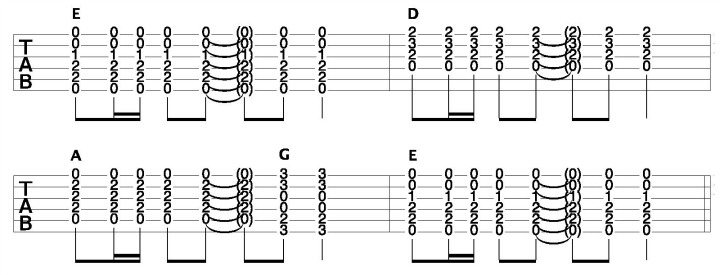Chord Shapes For Guitar - Playing Acoustic Guitar Chords
There are many creative ways you can play chords on your acoustic guitar. Today I want to show you a way to take some everyday chord progressions on your guitar and change the way they sound.
Lets start with 3 familiar chord shapes for the guitar:



* I have left the top string of the F form open for the purpose of todays lesson.
While these shapes for the guitar sound great in the open position, where they are most commonly played, they can also sound great in other areas of the fretboard.
It is important to note the E and F chord forms above are both fragments of the root 6 bar chord shape (see below). This will help greatly in the application of these chords.


When playing your guitar chords in this way, keep the shape exactly the same as you move it up and down the neck of the guitar. This means that all the open strings will remain constant (ie. the same) wherever you are, while the fretted notes of each chord shape will change. This will give you a variety of very interesting sounding chords.
Here is an example of what I am talking about using the E form:

What makes the above example sound interesting is how the open strings, that don’t change, react to the fretted notes of the chord shape, that do change.
As you play this, you will hear that the E form sounds better, or more “in”, in some positions compared to others. This is very true when playing chords on the guitar with this approach, however these chords need to be heard in context before making any judgements. So lets do that.
Here is a typical chord progression you might play on your guitar:

Using the F form, here is another way you could play it:

As you can hear we get quite a different sound when playing our chords in this way. While the first progression is more typical, and how you would play more often, this way provides a great sounding alternative.
Remember that the F form I am using above can be seen as part of the root 6 bar chord shape. This is why I have placed it at the 5th position for the A chord, the 3rd position for the G, and the 8th and 10th positions for the C and D chords respectively.
A big reason for getting the sound we do when playing chords on the acoustic this way is the open strings. In the above example both the E and A strings remain constant as the chord moves up and down the fretboard. These open strings relate differently to each chord, and as a result give us a variation in the sound of that chord.
Here is another example of a typical chord progression you might play:

and here is how you could play it with the E form this time:

* Remember that the E form can be thought of as a fragment of the root 6 bar chord shape.
A great way to play these acoustic chords is to break them up and play the notes separately. I have done this briefly in the 3rd bar of our example above, but have taken it much further in the next progression.
Here is that progression as you would normally play it:

and here it is, this time using the C form:

* The C form doesn’t relate to the root 6 bar chord shape as the E and F do. However, it takes it’s root note from the 5th string as a root 5 bar chord does, so this should help in knowing where to place it for each chord.
Again, the open strings are what drive the sound you get when playing these chords on your guitar this way.
As always, the key is in doing this yourself. So, take some progressions you know and apply the ideas you have learned in this lesson using the E, F, and C chord shapes. It’s really quite simple to do.
Here are some examples of songs to leave you with, that use this approach:
- Ramble On - Led Zeppelin (pretty much throughout the whole song)
- Rooster - Alice in Chains (Root 6 Chords being used with top 2 strings left open)
- Taylor - Jack Johnson ( 3.20 into song, C chord form moving up the fretboard)
Learn how to fingerpick guitar with these step by step beginner fingerstyle guitar lessons